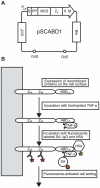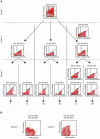Engineering bispecificity into a single albumin-binding domain
- PMID: 21991353
- PMCID: PMC3185003
- DOI: 10.1371/journal.pone.0025791
Engineering bispecificity into a single albumin-binding domain
Abstract
Bispecific antibodies as well as non-immunoglobulin based bispecific affinity proteins are considered to have a very high potential in future biotherapeutic applications. In this study, we report on a novel approach for generation of extremely small bispecific proteins comprised of only a single structural domain. Binding to tumor necrosis factor-α (TNF-α) was engineered into an albumin-binding domain while still retaining the original affinity for albumin, resulting in a bispecific protein composed of merely 46 amino acids. By diversification of the non albumin-binding side of the three-helix bundle domain, followed by display of the resulting library on phage particles, bispecific single-domain proteins were isolated using selections with TNF-α as target. Moreover, based on the obtained sequences from the phage selection, a second-generation library was designed in order to further increase the affinity of the bispecific candidates. Staphylococcal surface display was employed for the affinity maturation, enabling efficient isolation of improved binders as well as multiparameter-based sortings with both TNF-α and albumin as targets in the same selection cycle. Isolated variants were sequenced and the binding to albumin and TNF-α was analyzed. This analysis revealed an affinity for TNF-α below 5 nM for the strongest binders. From the multiparameter sorting that simultaneously targeted TNF-α and albumin, several bispecific candidates were isolated with high affinity to both antigens, suggesting that cell display in combination with fluorescence activated cell sorting is a suitable technology for engineering of bispecificity. To our knowledge, the new binders represent the smallest engineered bispecific proteins reported so far. Possibilities and challenges as well as potential future applications of this novel strategy are discussed.
Conflict of interest statement
Figures






Similar articles
-
Engineering of bispecific affinity proteins with high affinity for ERBB2 and adaptable binding to albumin.PLoS One. 2014 Aug 4;9(8):e103094. doi: 10.1371/journal.pone.0103094. eCollection 2014. PLoS One. 2014. PMID: 25089830 Free PMC article.
-
Development and characterization of small bispecific albumin-binding domains with high affinity for ErbB3.Cell Mol Life Sci. 2013 Oct;70(20):3973-85. doi: 10.1007/s00018-013-1370-9. Epub 2013 Jun 2. Cell Mol Life Sci. 2013. PMID: 23728098 Free PMC article.
-
Orthogonal protein purification facilitated by a small bispecific affinity tag.J Vis Exp. 2012 Jan 16;(59):3370. doi: 10.3791/3370. J Vis Exp. 2012. PMID: 22297419 Free PMC article.
-
Current strategies in antibody engineering: Fc engineering and pH-dependent antigen binding, bispecific antibodies and antibody drug conjugates.Biotechnol J. 2012 Dec;7(12):1444-50. doi: 10.1002/biot.201200250. Epub 2012 Nov 1. Biotechnol J. 2012. PMID: 23125076 Review.
-
Engineered antibodies.Nat Med. 2003 Jan;9(1):129-34. doi: 10.1038/nm0103-129. Nat Med. 2003. PMID: 12514726 Review. No abstract available.
Cited by
-
The albumin-binding domain as a scaffold for protein engineering.Comput Struct Biotechnol J. 2013 Sep 1;6:e201303009. doi: 10.5936/csbj.201303009. eCollection 2013. Comput Struct Biotechnol J. 2013. PMID: 24688717 Free PMC article. Review.
-
Targeting HER2 Expressing Tumors with a Potent Drug Conjugate Based on an Albumin Binding Domain-Derived Affinity Protein.Pharmaceutics. 2021 Nov 3;13(11):1847. doi: 10.3390/pharmaceutics13111847. Pharmaceutics. 2021. PMID: 34834262 Free PMC article.
-
Surface display of a single-domain antibody library on Gram-positive bacteria.Cell Mol Life Sci. 2013 Mar;70(6):1081-93. doi: 10.1007/s00018-012-1179-y. Epub 2012 Oct 13. Cell Mol Life Sci. 2013. PMID: 23064703 Free PMC article.
-
Staphylococcus carnosus: from starter culture to protein engineering platform.Appl Microbiol Biotechnol. 2017 Dec;101(23-24):8293-8307. doi: 10.1007/s00253-017-8528-6. Epub 2017 Oct 2. Appl Microbiol Biotechnol. 2017. PMID: 28971248 Free PMC article. Review.
-
Multiplex epitope mapping using bacterial surface display reveals both linear and conformational epitopes.Sci Rep. 2012;2:706. doi: 10.1038/srep00706. Epub 2012 Oct 4. Sci Rep. 2012. PMID: 23050090 Free PMC article.
References
-
- Reichert JM. Monoclonal antibodies as innovative therapeutics. Curr Pharm Biotechnol. 2008;9:423–430. - PubMed
-
- Leader B, Baca QJ, Golan DE. Protein therapeutics: a summary and pharmacological classification. Nat Rev Drug Discov. 2008;7:21–39. - PubMed
-
- Nygren PA. Alternative binding proteins: affibody binding proteins developed from a small three-helix bundle scaffold. FEBS J. 2008;275:2668–2676. - PubMed
-
- Holliger P, Hudson PJ. Engineered antibody fragments and the rise of single domains. Nat Biotechnol. 2005;23:1126–1136. - PubMed
-
- Lofblom J, Frejd FY, Stahl S. Non-immunoglobulin based protein scaffolds. Curr Opin Biotechnol. 2011;22:1–6. - PubMed
Publication types
MeSH terms
Substances
LinkOut - more resources
Full Text Sources
Other Literature Sources

